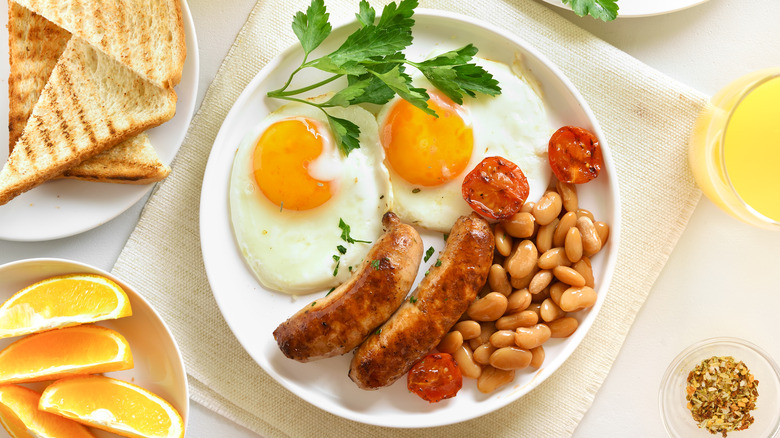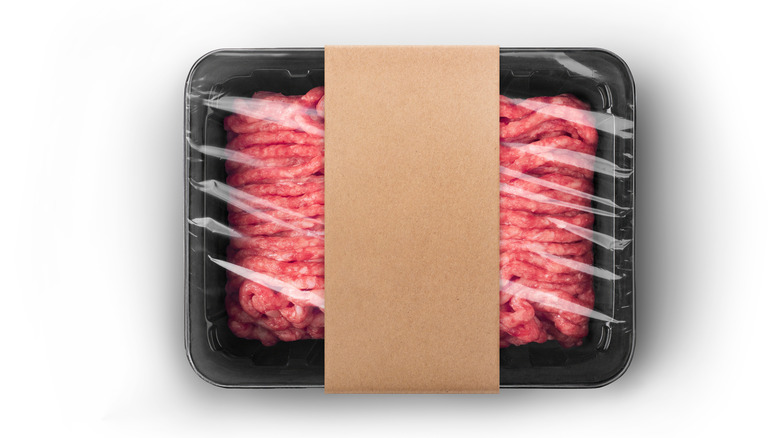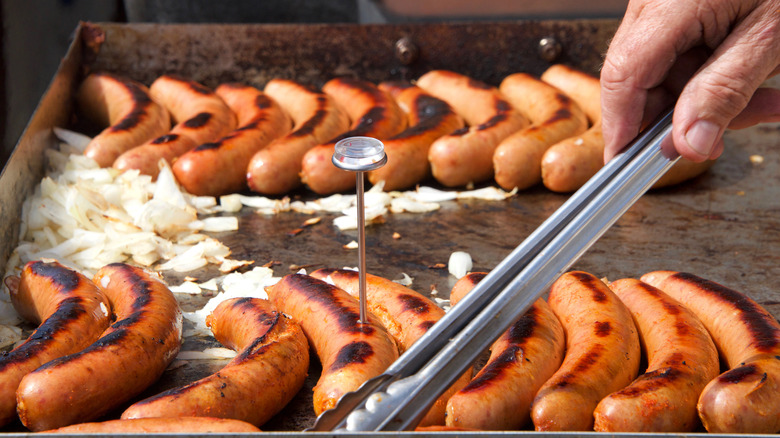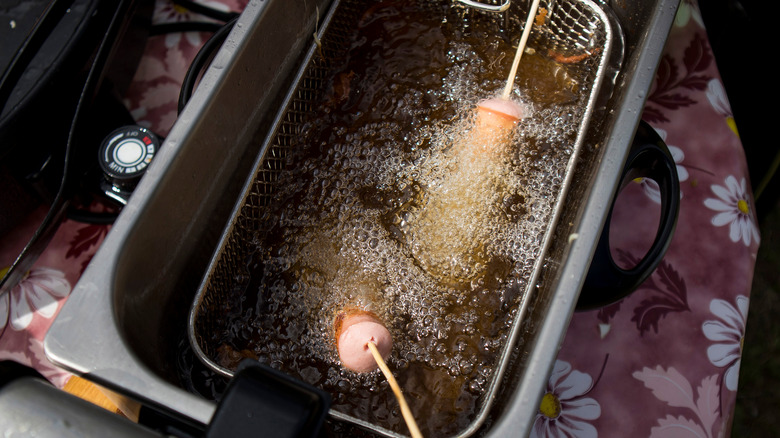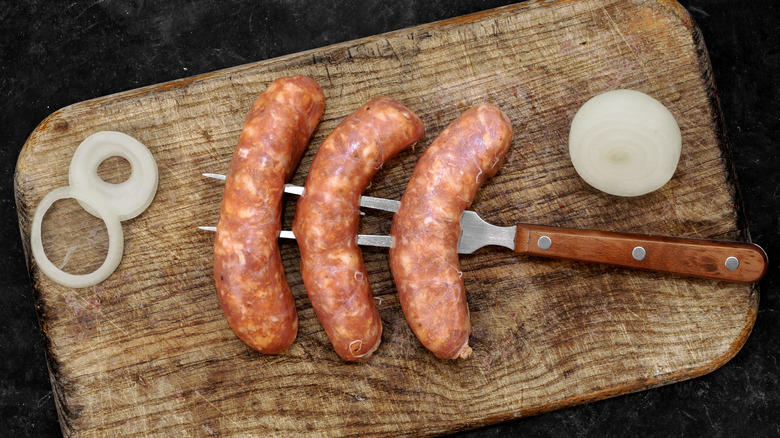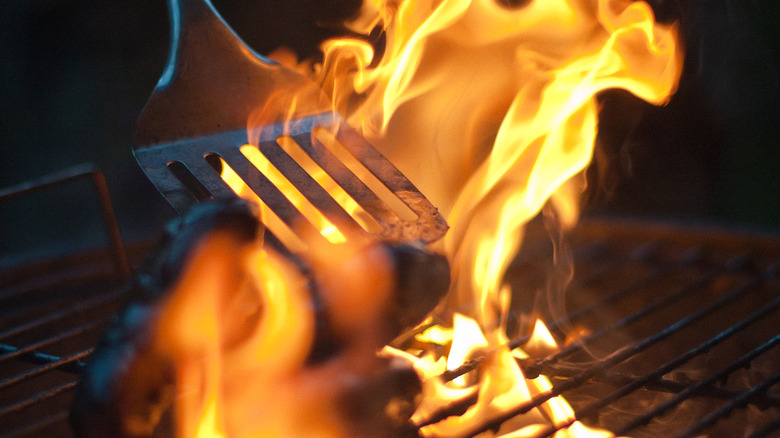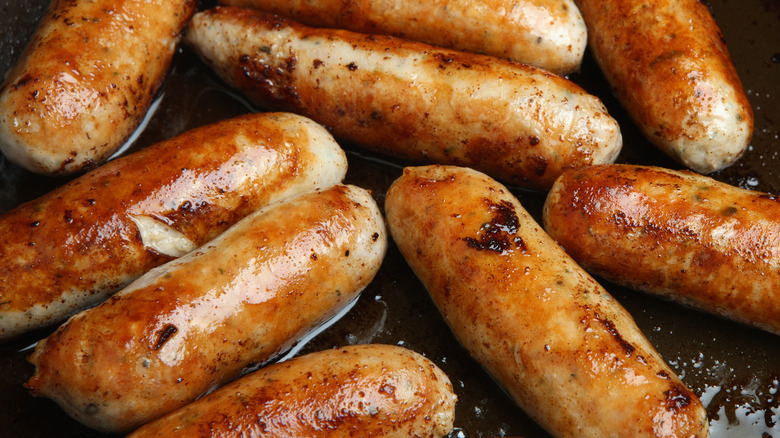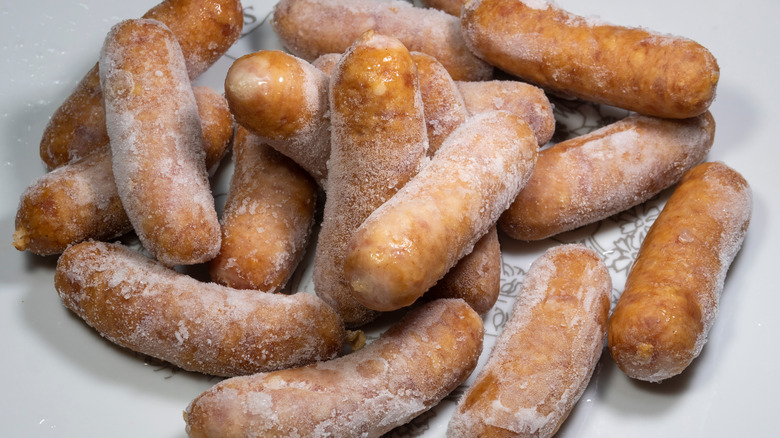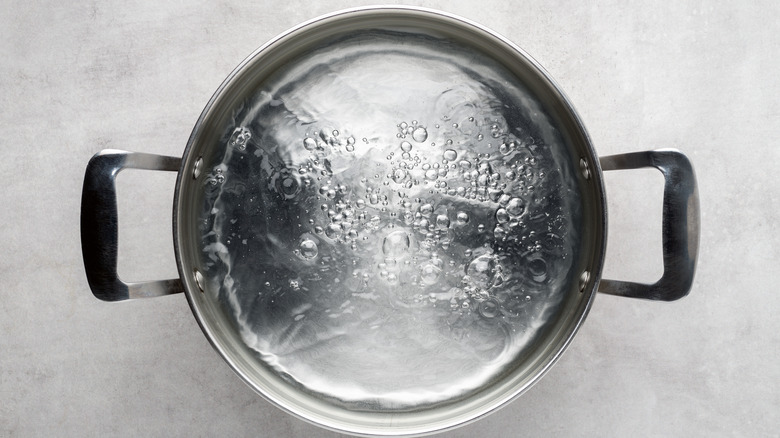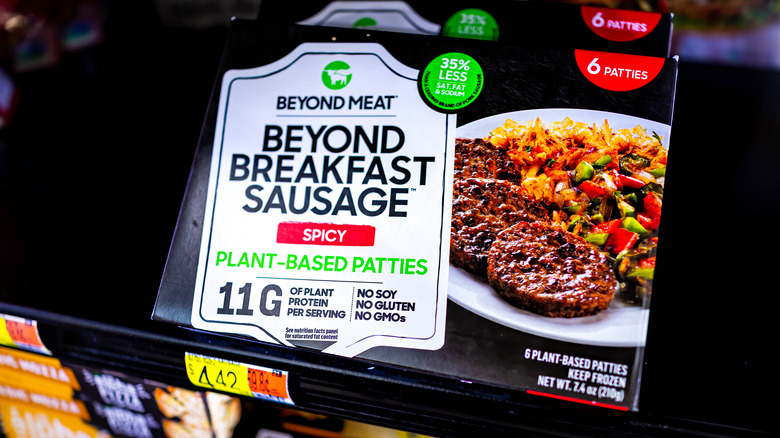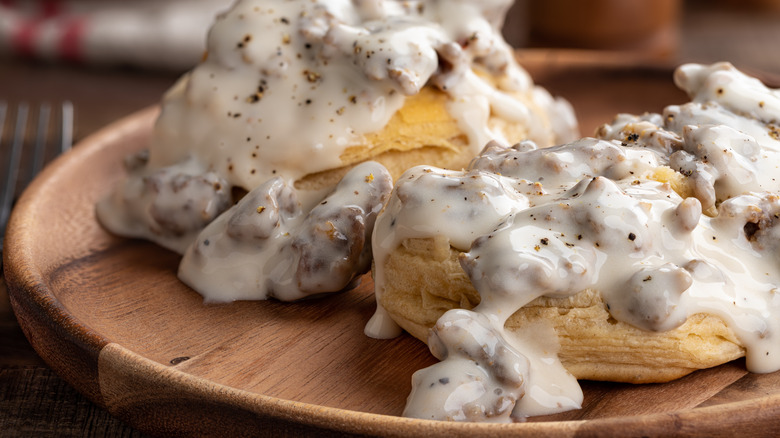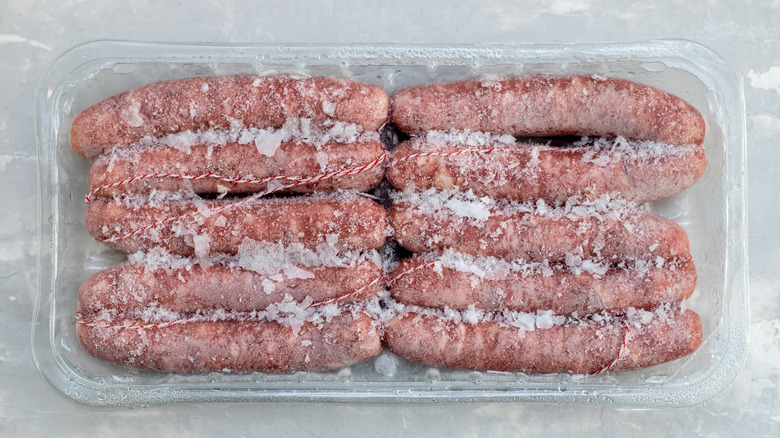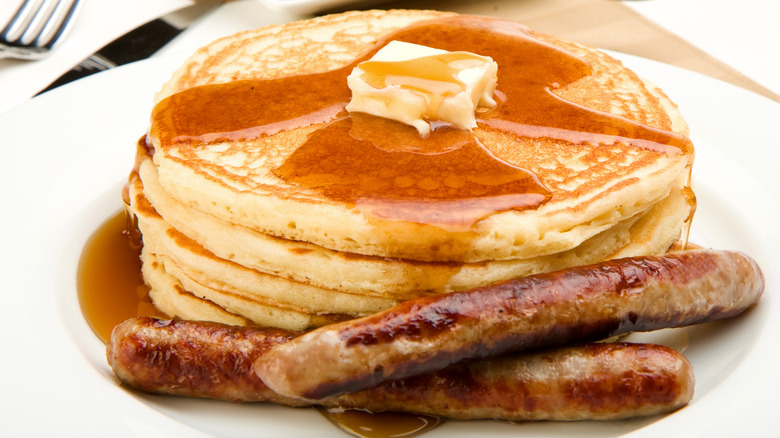12 Mistakes Everyone Makes When Cooking Breakfast Sausage
We may receive a commission on purchases made from links.
It's a drive-through breakfast staple that makes every up-and-at-'em egg sandwich more flavorful and filling. It's a quick-to-make morning savior that turns an average pancake breakfast awesome. But are you getting the most out of your breakfast sausage? Whether you prefer links or patties, crumbles or casings, it's easier than you might think to mess up this perfectly good protein.
No one wakes up looking forward to dry patties, tough-to-chew links, or undercooked insides. With a little bit of know-how, you can take any simple, so-so breakfast to the next level of daybreak deliciousness. Try something new, brush up on your technique, or learn what to steer clear from when it comes to cooking a special brunch in your own kitchen. Here are some common mistakes even the best of us make when cooking breakfast sausage, and, most importantly, how to avoid those mistakes and get the most out of your meat.
1. Not making them from scratch
Yes, frozen breakfast sausage is super convenient. But it's also super salty, not fresh, and not always up to your foodie standards. Lucky for us, there are some really great (and easier than you think) breakfast sausage recipes to get you started down the path to becoming your own Jimmy Dean self. You can make patties, links, or sausages with casing if you're super confident—and have the right equipment.
Another benefit to homemade sausages? You get to see how the sausage is made. Jokes aside, you control the seasonings, the quality of the meat, and how long it's kept. If you still want a really convenient option, you can always freeze your homemade sausage and warm it up on any busy morning.
Take this recipe loaded with sage and thyme — shape it into patties or links, or cook it in crumbles with eggs and home fries to make a delicious morning scramble.
2. Not using a meat thermometer
Cooking a sausage right includes not only browning it on the outside, but warming the middle fully. Make any guesswork on your sausages' doneness, and you could end up with browned links with cold centers or sausages that are dry and overcooked inside. For best results, use a meat thermometer to make sure that the innermost part of the meat is at 160°F for beef, pork, or lamb and 165 for chicken or turkey (via USDA).
Digital pen thermometers are inexpensive and easy to use, but you can also use an old-school analog thermometer to check how long you need to keep those mouthwatering sausages cooking. Other models include pens that stay inside the meat as it cooks, then beep to alarm you when it's reached your desired temperature. This hands-off method means you don't have to babysit your breakfast and can focus on making those perfect eggs while your sausages are on the griddle.
3. Deep-frying the sausages
Okay, so most everything tastes better deep-fried. (Looking at you, Oreos.) But deep-frying sausages can make the meat — and its casings, if it has them—overcooked and too dry and tough to enjoy. Plus, even if you're careful with the heat and the sausages aren't overcooked, the oil in the deep fryer is adding to the sausages' already high-fat content.
There is one exception to the no-deep-frying rule: breakfast sausage dipped in pancake batter (via Food Network). This breakfast take on the corn dog works because the batter protects the sausage from becoming tough and overcooked, and just tastes downright delicious.
This all begs the question, though — what about air frying? You can definitely cook your sausages in the air fryer. Just be careful with the heat setting, as it's easy to overcook your sausages at high heat. Ketofocus recommends making your sausages in the air fryer at 360°F and cooking sausages for 8-10 minutes on each side.
4. Pricking your breakfast sausages with a fork before cooking
Some of us, whether by force of habit or from having seen mom or grandma do it in their kitchen long ago, might think pricking breakfast sausages with a fork is a good idea. The idea might be to let some of the fat out while the sausages cook, or maybe to prevent the casings from splitting completely open while cooking. Turns out, though, according to an expert at Good Food Australia, pricking sausages with a fork is totally not necessary and can cause the juices (aka fat) that make breakfast sausage delicious to run out before you even get your first bite.
To prevent sausages from splitting, avoid cooking them over high heat. Keep those delicious fats inside, and let your sausages rest a minute or five before you dig in. This will help the juices and flavor stay in the meat to an even higher (and more delicious) degree.
5. Starting your breakfast sausages on a high heat cook
It's tempting to blast your breakfast sausage with high temperatures to get them ready to eat in as little time as possible. But high heat can crisp up and brown — or burn — your breakfast sausages' exteriors before the insides are fully cooked, or even warmed. To avoid this, skip the microwave. Heat in a microwave can get out of control in a hurry, and you won't even know your sausages are toast until it's way too late, when you take them out of the microwave.
Likewise, it's best to avoid high heat in the skillet. Avoid this common sausage cooking mistake and cook them over medium heat until their innermost portion reaches 160°F (which you'll know if you use your handy thermometer). If you really, really want to sear your sausages, do it for a minute or two on each side over high heat before reducing the heat to cook for another 5 minutes per side.
6. Crowding the sausages in the pan
Another pitfall of trying to cook in a hurry? Putting too many sausages in a pan together at one time. Avoid the temptation to cook a whole lot of sausages at once. Cooking in batches is the best way to get the ideal texture and doneness.
When food, including sausages, is cooked too close together, the moisture inside of it is less able to escape, trapping steam around the food. Squeezing as many as you can together in the skillet (or baking sheet) will steam them, instead of browning them (via Real Simple).
It's important to give your sausages some space to make sure they get a nice crispy coating. Serious Eats explains that this browning is known as the Maillard reaction, which transforms raw ingredients into foods with enticing aromas, complex flavors, and satisfying textures. So next time you cook breakfast sausage, allow yourself enough time and space to cook it in batches that brown beautifully.
7. Thawing sausages at room temperature
Thawing breakfast sausages at room temperature is only a recipe for bacteria growth. (Bacteria that can cause foodborne illness can grow exponentially at room temperature, doubling in bacterial growth in only 20 minutes according to the FDA.) If you're using store-bought sausage, check the label's instructions to find out if you can cook them directly from frozen. If your sausage must be thawed, do it in the refrigerator (where the temperature is below the FDA's "danger zone" of 40°F) overnight.
Forgot to thaw overnight? MasterClass suggests a slightly faster method of thawing is to seal your sausage in a zip-top bag, and submerge the bag in a large bowl of cold water, changing the water every 30 minutes or so. For a last-minute option, you can also defrost breakfast sausage in the microwave. Just check them (and rotate, if necessary) every few minutes to make sure they're not fully cooking in there.
8. Not boiling the breakfast sausages
Okay, so only boiling breakfast sausage is not a recipe for deliciously browned meat, but for some varieties of breakfast sausage, a successful cook definitely starts with a hot pot of boiling water (per Bon Appetít).
If your breakfast sausage has casing, or skin, get that hot pot ready. Your best method for cooking them is to simmer them before you brown them. Often, sausages with casing are fresh (and the meat is raw), so it's extra important to both cook them completely through and brown them on the outsides. Boil your breakfast sausage in a pot filled with just enough water to cover the sausages for 6-8 minutes. Next, fry sausages in a skillet over medium heat for several minutes until heated through, turning to brown all sides. It's again important not to crowd your pot or the skillet, to get that nice and crispy umami bite in every juicy link.
9. Not trying healthier options
Walk through nearly any grocery store today and you might feel overwhelmed by the "health food" options. It seems there are products marketed toward every possible dietary need — thankfully so — but it can be hard to keep it all straight. Between Keto, low-carb, gluten-free, dairy-free, and plant-based diets, it can be tough to know what's truly "healthy" for you and what's just a trend.
Here's what hasn't changed: with high fat and sodium content, most pre-made breakfast sausage may be better off as a "sometimes" food than an everyday staple (via Very Well Fit). But meatless and poultry options that pack the same amount of flavor as traditional, fatty sausages are out to change that. You can buy frozen turkey, plant-based, chicken, or lean pork sausages that all balance a healthier nutritional profile with plenty of flavor (via PETA).
You can also make your own healthier sausages, with lean ingredients such as ground chicken breast or venison. You're in total control of the ingredients, so you can feel good about what's gone into your breakfast.
10. Not crumbling the sausage
We've focused here mostly on links and patties, which are easy to cook and serve, and ideal for stacking on breakfast sandwiches or wrapping in pancakes. But what about crumbles? Try buying a roll of often-overlooked fresh breakfast sausage. While these thick rolls of raw sausage are often marked for slicing into patties, you can just as easily turn them into crumbles for biscuits and gravy (or even a sausage dinner skillet). Crumbles also lend themselves deliciously to scrambled-egg bowls, breakfast burritos, breakfast hash, and more.
What's more, cooking sausage crumbles can be a lot more straightforward than cooking links or patties: To cook, Jimmy Dean for example, remove it from the casing and break it into crumbles in a skillet over medium-high heat, cooking for 8-10 minutes. (There are also pre-cooked, pre-crumbled bags of frozen sausage that are super easy and fast to microwave, if that's what you're into).
All you have to keep in mind while cooking is to make sure not to overcook the sausage, and you'll be set — with powerful flavors and juicy textures that will set a delightful tone for the rest of your day.
11. Keeping the breakfast sausages too long
If your sausage is fresh or homemade, the USDA recommends it's best to use it within a day or two for quality and safety's sake. Smoked sausage or vacuum-sealed sausage can last longer — just check the use-by date on the packaging. Even still, leftovers shouldn't be kept in the fridge for more than a day or two.
When it comes to frozen sausages, the USDA says that freezing keeps sausage safe indefinitely. But if you want your frozen breakfast sausage to taste any better than "safe," make a point of using it within a month or two of bringing it home. Any more than that, and you risk freezer burn, condensation, and a loss of flavor and quality.
Some breakfast sausages come in a cardboard box or other packaging that can be difficult (or impossible) to re-seal after using a portion of the meat. For best results, freeze any unused frozen sausages in a freezer-safe zip-top bag, or other airtight freezer container. Be sure to label the bag or container with the date you stash it, and let it go if you haven't used it in less than two months.
12. Not dipping them in syrup
The salty/sweet combo might be the very best thing about breakfast sausage, TBH. Whether you're having pancakes, waffles, French toast or crepes with your sausage, you're going to want to save some of that sweet maple syrup for your meat. So what if the first time you tried it was by accident, when the syrup pooled around the sausage? It's totally acceptable (and delicious) to dip your sausage in syrup entirely on purpose from here on out.
Want to level up your syrup-sausage game? Try making a copycat of McDonald's famous sausage McGriddle. Some homemade sausage recipes may even include maple syrup inside the links or patties, but you might still want to dip it in some straight-up, too.
If you're feeling really adventurous, turn your pancake into a breakfast taco shell of sorts: fill it with scrambled eggs and sausage, fold, then drizzle with syrup. You can thank us later.
